Research - (2021) Volume 9, Issue 1
Awareness on Lifestyle Modifications Among Dental Students
Nivedha Valliammai Mahalingam, Vishnu Priya V* and Gayathri R
*Correspondence: Vishnu Priya V, Department of Biochemistry, Saveetha Dental College and Hospitals, Saveetha Institute of Medical and Technical Sciences, Saveetha University Tamilnadu, India, Email:
Abstract
Exercise is a regular physical activity that can improve muscular strength, boost endurance, delivers oxygen and nutrients to the tissues, and helps the cardiovascular system work efficiently. The aim of this study is to evaluate the knowledge and practice of physical exercise and the lifestyle modifications among dental students. This questionnaire-based survey was administered to dental students through an online survey planet link. The data was collected and statistically analysed. Students practicing regular exercise with a balanced diet supports to keep them fit, energetic, flexible, weight loss, improves concentration, stress management. Despite students being aware about the benefits of regular exercise they are unable to practice it on a regular basis due to lack of sufficient time, self-motivation. The survey results indicate that most of the college students get adapted to irregular exercise habitual and unhealthy lifestyle patterns. Exercise with a balanced diet helps dental students to improve concentration, reduce stress and maintain physical fitness. Lack of sufficient time terms to be the biggest barrier among students to perform exercise regularly. Irregular exercise patterns persist among most of the dental students hence resulting in an unhealthy lifestyle. This study has created an awareness among the dental students about practicing regular exercises and its effects on lifestyle modification. More awareness camps, seminars, workshops may be conducted to motivate the students in a stronger way to follow a regular workout.
Keywords
Exercise, Lifestyle modification, Survey planet, Online survey
Introduction
The definition proposed by Dr Andrija Stampar, a prominent scholar from Croatia in the field of social medicine and public health and one of the founders of the WHO states that “health is a state of complete physical, mental, and social wellbeing and not merely the absence of disease or infirmity” [1]. Health is defined as operational and working terms vital for creating policies and programs for maintaining and improving health, and it considerably managed to exceed the widely rooted notion that health simply means the absence of disease. The Ottawa Charter from the 1st International Conference on Health Promotion, held in Ottawa, Canada, in 1986, defines that the word " health" has originated in the context of everyday life and environment, where people live, love, work, and play. The goal of health is to combine the approach for addressing the social determinants with the resolution and commitment to motivate and encourage the individuals and the community for their active approach toward health and embracing healthy lifestyles [2].
Physical activity is defined as any bodily movement produced by skeletal muscles that results in energy expenditure. The energy expenditure can be measured in kilocalories. Physical activity in daily life can be categorized into occupational, sports, conditioning, household, or other activities [3]. Exercise is a subset of physical activity that is planned, structured, and repetitive and has as a final or an intermediate objective the improvement or maintenance of physical fitness. Exercise is the proven method in improving physical health. The low intensity exercise gives the high energy level which boosts the mental and physical strength [4]. Hence there is always a connection between being physically healthy and delivering strong academic performance.
Exercise produces a protein called FNDC5, which is released into the bloodstream. This helps the brain to produce another protein called brainderived neurotrophic factor (BDNF), which prompts the body to produce new nerves and helps existing brain cells to survive. Intense physical activity initiates the blood flow to the brain, which in turn produces neurons and promotes cell growth. Different types of exercise instigate the brain in different ways, which means certain forms of physical activity will support in increasing the concentration than others. Stress can lead to health problems, such as heart attacks and stomach problems. Exercise helps to sleep better, easing anxiety, relieve the negative effects of stress in the body.
Numerous studies have shown that lifestyle modification such as adopting a healthier diet, increasing physical activity levels and smoking cessation can be effective in the prevention and management of chronic diseases, provided that the health promoters have sufficient knowledge and resources [5]. An important developmental task for college students is to manage their excess stress while actively engaging with healthy, ageappropriate challenges that promote growth. Studies were conducted earlier for evaluating the effectiveness of meditation-based intervention for reducing distress and enhancing well-being among college undergraduate populations [6]. Previous studies on cancer biology nano materials, herbal products [7-12] have motivated me to pursue this current research which is useful to our community. The aim of this study is to evaluate the knowledge and practice of physical exercise and the lifestyle modifications among dental students.
Materials and Methods
This questionnaire-based survey is designed based on awareness on the effects of exercise in lifestyle modification among dental students. Data were collected through a survey questionnaire with 15 questions that were filled in an online survey planet link. This study was approved by the Institutional Review Board, Saveetha Dental College. Overall, 100 participants took part in the survey. The questions based on their workout schedules, stress management, daily workout, advantages, and factors disturbing their workout plans were asked to the participant through the link. Among these questions, eight questions were with yes or no options. Other questions are given with appropriate options. The data was collected and statistically analyzed.
Results and Discussion
Out of 100 Participants who took part in the survey, Figure 1: 62% of participants exercise everyday 38% of participants exercise at irregular intervals. Figure 2: 45% of participants exercise half an hour a day, 39% exercise 10 mins a day, 16% one hour a day and 15% exercise more than one hour a day. Figure 3: 40% of respondents wanted to keep fit 12% respondents opt to give more energy, 14% of respondents opt to increase flexibility, 31% of respondents opt to lose weight and 3% of respondents opt for others. Figure 4: 40% of participants say they have good level of fitness, 45% of participants say average level of fitness, 7% say perfect level of fitness and 7% say unfit. Figure 5: 91% of participants agree exercise helps to reduce stress and 9% disagree with this statement. Figure 6: 50% of participants agreed that lack of time as a barrier that prevents them from exercising regularly, 25% of participants opt not self-motivated, 18% opt too tired, 6% of participants opt not really enjoying exercise. Figure 7: 96% of participants agree exercise along with a balanced diet helps to keep them fit and 4% disagree with this statement. Figure 8: 50% of participants agreed for indoor exercise and 50% for outdoor exercise. Figure 9: 84% of participants are gym users and 14% are not. Figure 10: 87% of participants agreed that regular exercise helps to concentrate in their studies and 13% disagree.
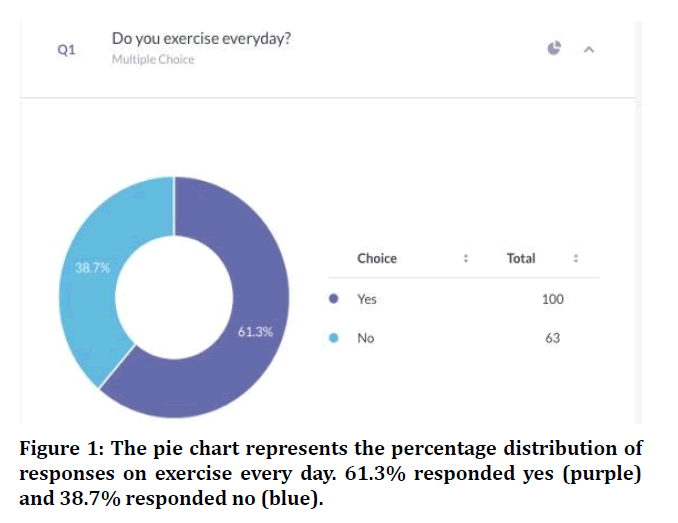
Figure 1: The pie chart represents the percentage distribution of responses on exercise every day. 61.3% responded yes (purple) and 38.7% responded no (blue).
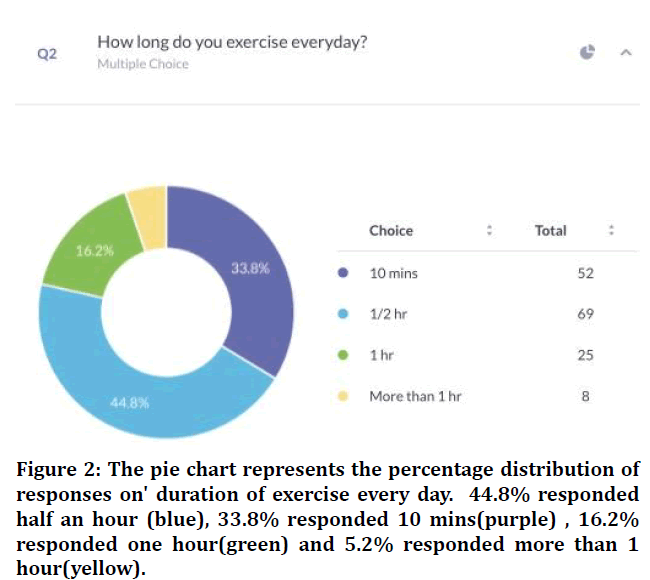
Figure 2: The pie chart represents the percentage distribution of responses on' duration of exercise every day. 44.8% responded half an hour (blue), 33.8% responded 10 mins(purple) , 16.2% responded one hour(green) and 5.2% responded more than 1 hour(yellow).
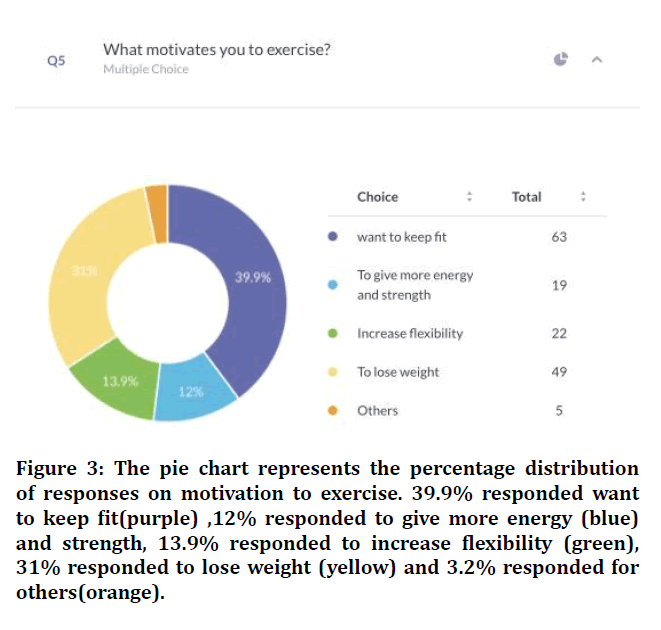
Figure 3: The pie chart represents the percentage distribution of responses on motivation to exercise. 39.9% responded want to keep fit(purple) ,12% responded to give more energy (blue) and strength, 13.9% responded to increase flexibility (green), 31% responded to lose weight (yellow) and 3.2% responded for others(orange).
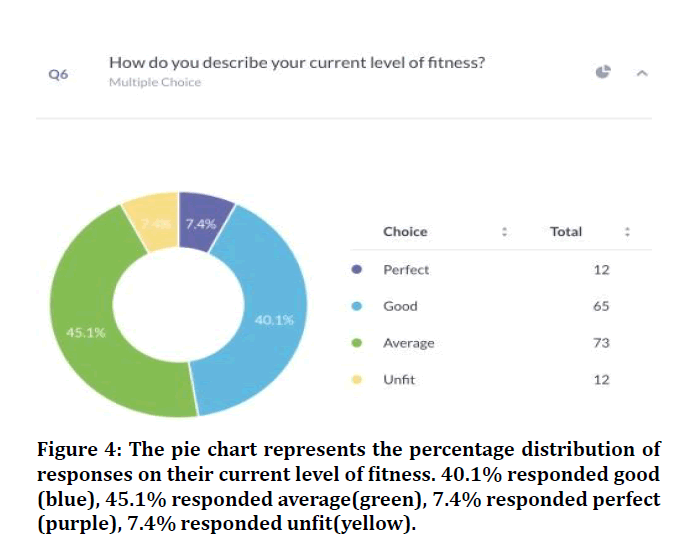
Figure 4:The pie chart represents the percentage distribution o f responses on their current level of fitness. 40.1% responded good (blue), 45.1% responded average(green), 7.4% responded c (purple), 7.4% responded unfit(yellow).
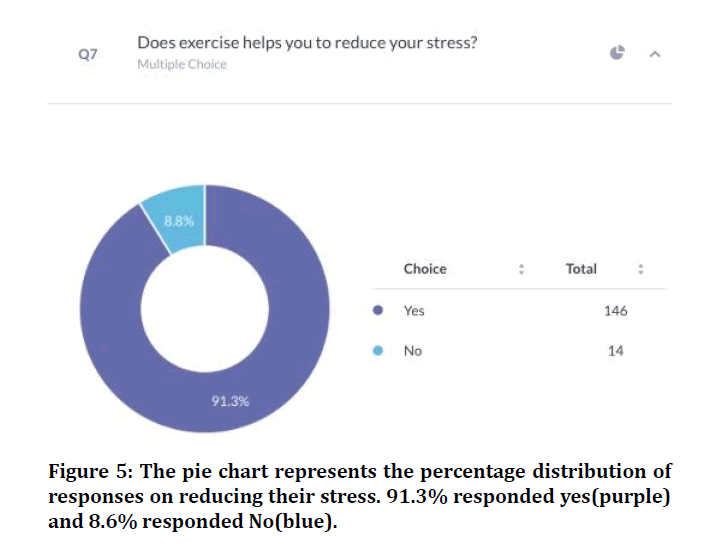
Figure 5:The pie chart represents the percentage distribution of responses on reducing their stress. 91.3% responded yes(purple) and 8.6% responded No(blue).
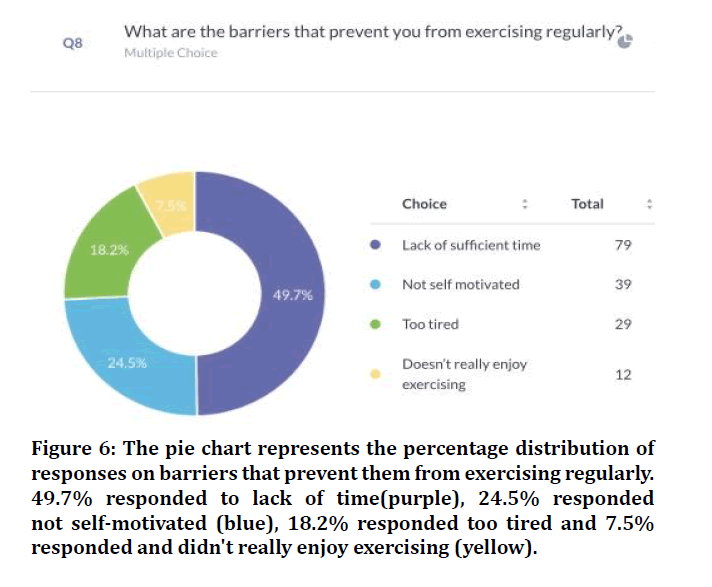
Figure 6:The pie chart represents the percentage distribution of responses on barriers that prevent them from exercising regularly. 49.7% responded to lack of time(purple), 24.5% responded not self-motivated (blue), 18.2% responded too tired and 7.5% responded and didn't really enjoy exercising (yellow).
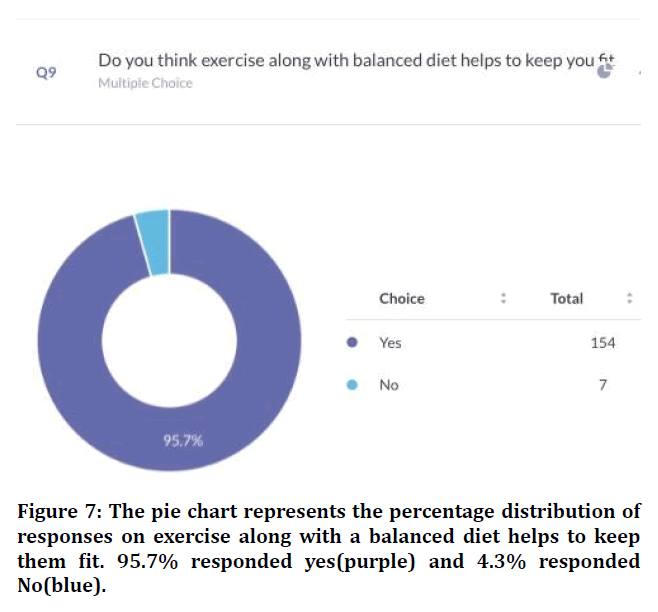
Figure 7:The pie chart represents the percentage distribution of responses on exercise along with a balanced diet helps to keep them fit. 95.7% responded yes(purple) and 4.3% responded No(blue).
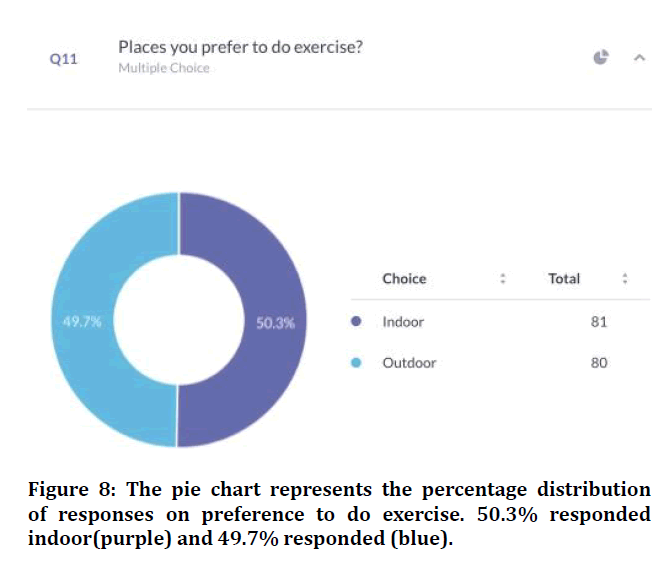
Figure 8:The pie chart represents the percentage distribution of responses on preference to do exercise. 50.3% responded indoor(purple) and 49.7% responded (blue).
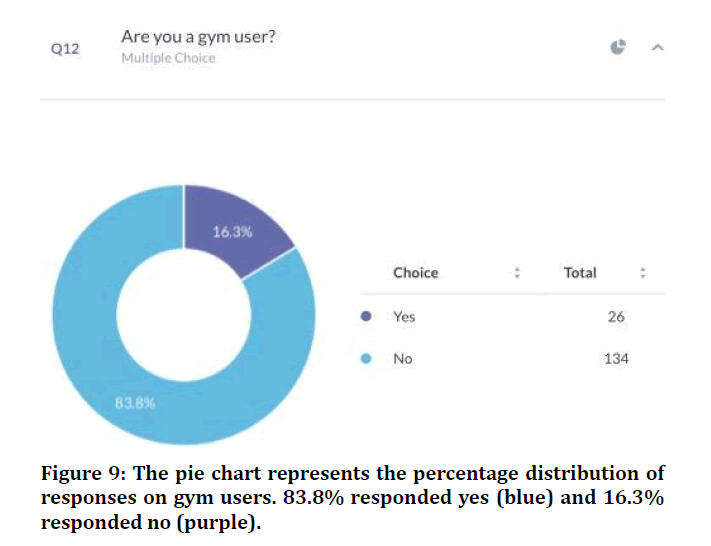
Figure 9:The pie chart represents the percentage distribution of responses on gym users. 83.8% responded yes (blue) and 16.3% responded no (purple).
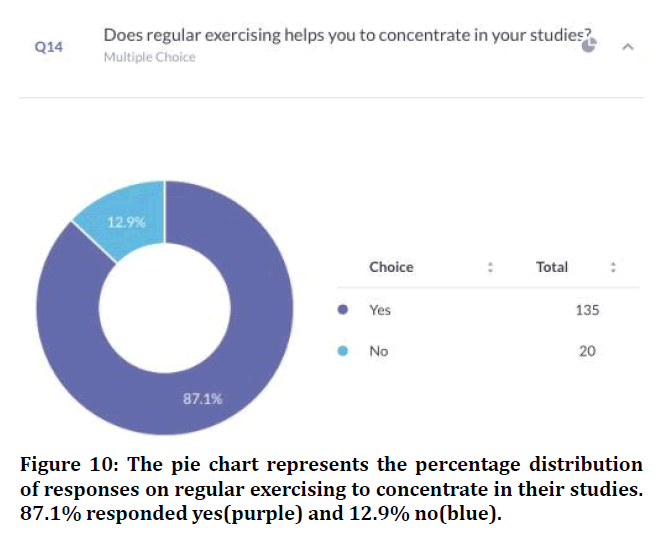
Figure 10:The pie chart represents the percentage distribution of responses on regular exercising to concentrate in their studies. 87.1% responded yes(purple) and 12.9% no(blue).
There are several personal habits that have the potential to impact health behaviors, including time management, academic activities, leisure activities and social media use. Despite the known benefits of regular physical activity, there is significant decline in physical activity participation and an increase in sedentary behavior among the college students. Physical activity is associated with decreased risk of heart disease, stroke, type-2 diabetes, metabolic syndrome, and lower all-cause mortality rate [13]. This study attempted to examine how lifestyle health behaviors in college student populations are related to academic factors and physical health outcomes. The implications of this study are relevant for college student healthcare providers, campus health and fitness departments and college administrators for informing preventative health interventions to impact lifelong health and fitness [14].
The sample in the current study states that awareness of BMI of Dental students is average due to irregular exercise. Similar Study conducted by Jesse Calestine et al. has concluded that there is a significant evidence among youth that indicates academic outcomes are positively related to better health outcomes though it appears that, among college students, the evidence is much less clear [15,16].
Our study showed that the main reason for irregular exercise during college days was due to time limitations. The issue of time limitations is consistent with the findings of a study conducted at Mansoura University in Egypt that found 35.5% of their students were not engaged in physical exercise due to time limitations [17]. Similarly, a study conducted among university students in Kuwait, and another study conducted in Muscat, both reported that not having enough time was one of the main barriers for not practicing sports [18]. Moreover, a study conducted in Spain among 1834 university students concluded that lack of time was the main barrier that prevented them from practicing sports. These findings emphasize that college students have increased demands to achieve academically, and therefore more time is devoted to studying leaving less time for practicing sports and exercise. Thus, available time would be the greatest obstacle that university students would face [19]. Physical activity is a culturally conditioned behavior. The benefits of regular physical activity are widely known and positively affect wellness by reducing stress and creating better relationships in college students. Similar study done by Simone Wilson- Salandy et al. have evaluated physical activity and the health behaviors of stress management, interpersonal relationships among college students [20].
Conclusion
Dental students are aware of exercise and its benefits to healthy living. Exercise helps to sleep better, easing anxiety, relieve the negative effects of stress in the body. Exercise has a unique capacity to exhilarate and relax, to provide stimulation and calm, to counter depression and dissipate stress. Regular physical activity will lower the blood pressure and reduce blood sugar. Exercise reduces the risk of heart attack, stroke, diabetes, colon and breast cancers, osteoporosis and fractures, obesity, depression, and even dementia (memory loss). Exercise slows the aging process, increases energy, and prolongs life. More awareness camps, seminars, workshops may be conducted to motivate the students in a stronger way to follow a regular workout.
Acknowledgement
The authors thank Saveetha Dental College for extending full support to complete this study.
Conflict of Interest
Nil.
References
- World Health Organization (2006) Constitution of the World Health Organization. CreateSpace Independent Publishing Platform.
- Svalastog AL, Donev D, Kristoffersen NJ, et al. Concepts and definitions of health and health-related values in the knowledge landscapes of the digital society. Croatian Med J 2017; 58:431–435.
- Caspersen CJ, Powell KE, Christenson GM. Physical activity, exercise, and physical fitness: Definitions and distinctions for health-related research. Public Health Reports 1985; 100:126–131.
- Li Y, Keeler LA, Jetter MJ. College health students’ knowledge and perceptions of exercise benefits and dysfunctional exercise. Californian J Health Promotion 2017; 15:67–76.
- Parker WA, Steyn NP, Levitt NS, et al. They think they know but do they? Misalignment of perceptions of lifestyle modification knowledge among health professionals. Public Health Nutrition 2011; 14:429–1438.
- Meenapriya M, Gayathri R, Priya VV. Effect of regular exercises and health benefits among college students. Drug Invention Today 2018; 10.
- Ponnulakshmi R, Shyamaladevi B, Vijayalakshmi P, et al. In silico and in vivo analysis to identify the antidiabetic activity of beta sitosterol in adipose tissue of high fat diet and sucrose induced type-2 diabetic experimental rats. Toxicol Mechanisms methods 2019; 29:276–290.
- Wu F, Zhu J, Li G, et al. Biologically synthesized green gold nanoparticles from Siberian ginseng induce growth-inhibitory effect on melanoma cells (B16). Artificial Cells Nanomed Biotechnol 2019; 47:3297–3305.
- Ke Y, Al Aboody MS, Alturaiki W, et al. Photosynthesized gold nanoparticles from Catharanthus roseus induces caspase-mediated apoptosis in cervical cancer cells (HeLa). Artificial Cells Nanomed Biotechnol 2019; 47:1938–1946.
- Ma Y, Karunakaran T, Veeraraghavan VP, et al. Sesame inhibits cell proliferation and induces apoptosis through inhibition of STAT-3 translocation in thyroid cancer cell lines (FTC-133). Biotechnol Bioprocess Engineering 2019; 24:646–652.
- Li Z, Veeraraghavan VP, Mohan SK, et al. Apoptotic induction and anti-metastatic activity of eugenol encapsulated chitosan nanopolymer on rat glioma C6 cells via alleviating the MMP signaling pathway. J Photochem Photobiol 2020; 203:111773.
- Chen F, Tang Y, Sun Y, et al. 6-shogaol, a active constiuents of ginger prevents UVB radiation mediated inflammation and oxidative stress through modulating NrF2 signaling in human epidermal keratinocytes (HaCaT cells). J Photochem Photobiol 2019; 197:111518.
- Chang T, Chopra V, Zhang C, et al. The role of social media in online weight management: Systematic review. J Med Internet Res 2013; 15:e262.
- Bopp M, Wilson OW, Papalia Z, et al. Freshmen physical activity habits and senior fitness levels: examining a healthy transition to college. Med Sci Sports Exercise 2019; 51:129.
- Burkhalter TM, Hillman CH. A narrative review of physical activity, nutrition, and obesity to cognition and scholastic performance across the human lifespan. Adv Nutrition 2011; 2:201S–206S.
- Dwyer T, Sallis JF, Blizzard L, et al. Relation of academic performance to physical activity and fitness in children. Pediatr Exercise Sci 2001; 13:225–237.
- El Gilany AH, Badawi K, El Khawaga G, et al. Physical activity profile of students in Mansoura University, Egypt. Eastern Mediterranean Health J 2011; 17:694–702.
- Musaiger AO, Al-Kandari FI, Al-Mannai M, et al. Perceived barriers to weight maintenance among university students in Kuwait: the role of gender and obesity. Environmental Health and Preventive Med 2014; 19:207–214.
- Gómez-López M, Gallegos AG, Extremera AB. Perceived barriers by university students in the practice of physical activities. J Sports Sci Med 2010; 9:374–381.
- Wilson-Salandy S, Nies MA. The effect of physical activity on the stress management. Interpersonal relationships, and alcohol consumption of college freshmen. SAGE Open 2012; 2:215824401246497.
Author Info
Nivedha Valliammai Mahalingam, Vishnu Priya V* and Gayathri R
Department of Biochemistry, Saveetha Dental College and Hospitals, Saveetha Institute of Medical and Technical Sciences, Saveetha University Tamilnadu, Chennai, IndiaCitation: Nivedha Valliammai Mahalingam, Vishnu Priya V, Gayathri R, Awareness on Lifestyle Modifications Among Dental Students, J Res Med Dent Sci, 2021, 9 (1): 87-91.
Received: 23-Sep-2020 Accepted: 11-Dec-2020
